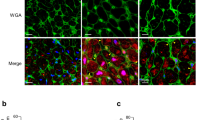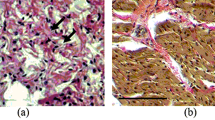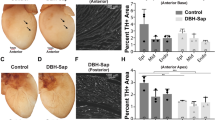Abstract
In general, it is recognized that prolonged exposure to catecholamine leads to a reduction in the β-adrenoceptor density (downregulation). However, it has been previously reported that the myocardial β-adrenoceptor densities and norepinephrine levels significantly increase in the hearts of BIO 14.6 cardiomyopathic hamsters in the early stage. The mechanism of the increased β-adrenoceptor density is not clearly elucidated, and it can not be excluded that this phenomenon may be a secondary effect. The purpose of this study was to assess the effect of verapamil on the density of β-adrenoceptors in the heart of BIO 14.6 cardiomyopathic hamsters. The total number of β-adrenoceptors in untreated BIO 14.6 hamsters was significantly higher at 90 days of age (30.4±2.2 v.s. 25.9±1.4 fmol/mg protein, p<0.05). BIO 14.6 hamsters received daily intraperitoneal injections of 5 mg/kg verapamil for 70 days, from an age of 20 days. Verapamil protected against progressive myocardial damage (total damage; 8.2±0.7 v.s. 0.4±0.2%/area, p<0.05) and the myocardial β-adrenoceptor density returned to that of the normal control group (26.9±3.0 fmol/mg protein). Conversely, verapamil did not have an effect on the number of myocardial β-adrenoceptors in normal golden hamsters. This study showed that verapamil protected against progressive myocardial damage and myocardial β-adrenoceptor density returned to those of normal hamsters. These results suggest that an increased number of β-adrenoceptors in the early stage of BIO 14.6 cardiomyopathic hamsters may be involved in the secondary pathogenesis of cardiomyopathy.
Similar content being viewed by others
References
Hammond HK, White FC, Buxton ILO, Saltzstein P, Brunton LL, Londhurst JC: Increased myocardial β-receptors and adrenergic responses in hyperthyroid pig. Am J Physiol 252: H283-H290, 1987
Limas C: Increased number of β-adrenergic receptors in the hypertrophied myocardium. Biochim Biophys Acta 588: 174–178, 1979
Karliner JS, Alabaster C, Stephens H, Barnes P, Dollery C: Enhanced noradrenaline response in cardiomyopathic hamsters. Possible relation to changes in adrenoceptors studied by radioligand binding. Cardiovasc Res 15:296–304, 1981
Sole MJ, Lo CM, Laird CW, Sonnenblick EH, Wurtman RJ: Norepinephrine turnover in the heart and spleen of the cardiomyopathic Syrian hamster. Circ Res 37:855–862, 1975
Ikegaya T, Nishiyama T, Kobayashi A, Yamazaki N: Role of 64-1 receptors and the effect of bunazosin on the histopathology of cardiomyopathic Syrian hamsters of strain BIO 14.6. Jpn Circ J 52: 181–187, 1988
Kobayashi A, Yamashita T, Kaneko M, Nishiyama T, Hayashi H, Yamazaki N: Effects of verapamil on experimental cardiomyopathy in the Bio 14.6 Syrian hamster. J Am Coll Cardiol 10: 1128–1134, 1987
Lowry OH, Rosebrough HJ, Farr AL, Randall NS: Protein measurement with the Folin phenol reagent. J Biol Chem 193: 265–275, 1951
Jasmin G, Solymoss B: Prevention of hereditary cardiomyopathy in the hamster by verapamil and other agents. Proc Soc Exp Bio Med 149: 193–198, 1975
Hedberg A, Kempf F, Josephson Jr ME, Molinoff PB: Coexistence of beta-1 and beta-2 adrenergic receptors in the human heart: Effects of treatment with receptor antagonists or calcium entry blockers. J Pharmacol Exp Ther 234: 561–568, 1985
Karliner JS, Motulsky HJ, Dunlap J, Brown JH, Insel PA: Verapamil competitively inhibits α1-adrenergic and muscarinic but not β-adrenergic receptors in rat myocardium. J Cardiovasc Pharmacol 4: 515–520, 1982
Nayler WG, Dillon JS, Sturrock WJ, Buckley DJ: Effect of chronic verapamil therapy on cardiac norepinephrine and β-adrenoceptor density. J Cardiovasc Pharmacol 12: 629–636, 1988
Gertz EW: Cardiomyopathic Syrian hamster: a possible model of human disease. Prog Exp Tumor Res 16: 242–260, 1972
Kessler PD, Cates AE, Dop CV, Feldman AM: Decreased biactivity of the guanine nucleotide-binding protein that stimulates adenylate cyclase in hearts from cardiomyopathic syrian hamsters. J Clin Invest 84: 244–252, 1989
Ikegaya T, Kobayashi A, Hong RB, Masuda H, Kaneko M, Yamazaki N: Stimulatory guanine nucleotide-binding protein and adenylate cyclase activities in Bio 14.6 cardiomyopathic hamsters at the hypertrophic stage. Molecul Cellular Biochem 110: 83–90, 1992
Gilman AG: G protein; transducer of receptor generated signals. Annu Rev Biochem 56: 615–649, 1987
Watanabe H, Kobayashi A, Yamamoto T, Suzuki S, Hayashi H, Yamazaki N: Alterations of human erythrocyte membrane fluidity by oxygen-derived free radicals and calcium. Free Radical Biol Med 9: 507–514, 1990
Strittmatter WJ, Hirata F, Axelrod J: Phospholipid methylation unmasks cryptic β-adrenergic receptors in rat reticulocytes. Science 204: 1205–1207, 1979
Heathers GP, Yamada KA, Kanter EM, Corr PB: Long-chain acylcarnitines mediate the hypoxia induced increase in α1-adrenergic receptors on adult canine myocytes. Circ Res 61: 735–746, 1987
Kaneko M, Chapman DC, Ganguly PK, Beamish RE, Dhalla NS: Modification of cardiac adrenergic receptors by oxygen free radicals. Am J Physiol 260: H821-H826, 1991
Sakanashi T, Sako S, Nozuhara A, Adachi K, Okamoto T, Koga, Toshima H: Vitamin E Deficiency has a pathological role in myocytolysis in cardiomyopathic Syrian hamster (BIO 14.6). Biochem Biophys Res Comm 181: 145–150, 1991
Tawarahara K, Kurata C, Taguchi T, Kobayashi A, Yamazaki N: Augmentation of β-adrenergic receptors in cardiomyopathic hamsters (BIO 14.6) with heart failure. Cardiovas Res 26: 526–533, 1992
Author information
Authors and Affiliations
Rights and permissions
About this article
Cite this article
Kobayashi, A., Nishiyama, T., Ikegaya, T. et al. Verapamil induced reduction of the myocardial β-adrenoceptor density in BIO 14.6 cardiomyopathic Syrian hamsters. Mol Cell Biochem 121, 59–65 (1993). https://doi.org/10.1007/BF00928700
Received:
Accepted:
Issue Date:
DOI: https://doi.org/10.1007/BF00928700




